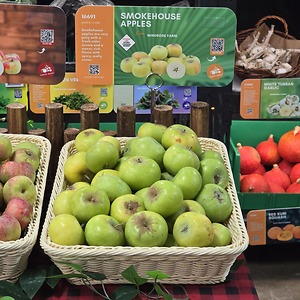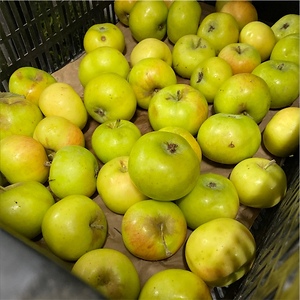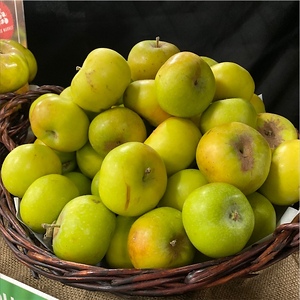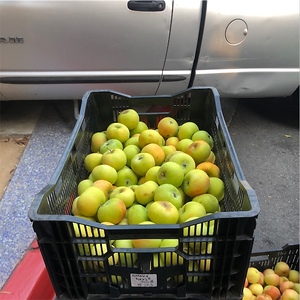

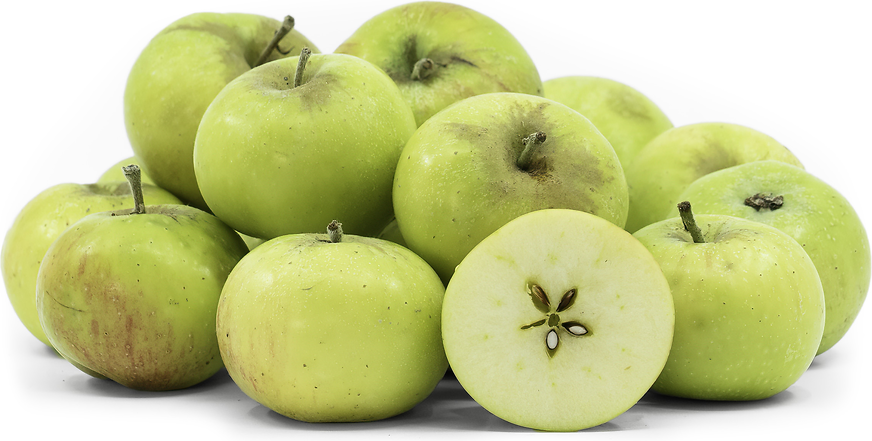
Smokehouse Apples
Estimated Inventory, lb : 0
This item was last sold on : 09/24/24
Description/Taste
Smokehouse apples are a medium to large varietal and have a round, conical, oblate shape with flattened shoulders and a broad, curved middle. The apple’s green-brown stem is fibrous, thin, and woody, connecting into a shallow stem cavity filled with textured, rough, light brown russet. The skin ripens from green to yellow-green and is blushed with patches of dull red-brown blush. The amount of blush varies per apple depending on sun exposure during cultivation. The blush can be muted and faint to more saturated and be striped or flushed. The skin also bears prominent tan lenticels across the surface that are occasionally russeted, and the surface is semi-thin but tough. Underneath the skin, the pale yellow to ivory flesh is dense, firm, fine-grained, and aqueous with a crisp and chewy mouthfeel. The flesh also encases a central core filled with tiny black-brown seeds. Smokehouse apples release a fresh, cider-like aroma when ripe and have moderate sugar and acidity levels, reaching around 10.7% Brix, a measurement of sugar in the flesh. The apples are known for their sweet-tart, balanced taste with rich caramel, spice, malt, and vinous undertones.
Seasons/Availability
Smokehouse apples are harvested in the fall and can be stored through early spring.
Current Facts
Smokehouse apples, botanically classified as Malus domestica, are an American variety belonging to the Rosaceae family. The mid to late-season cultivar is an heirloom variety discovered as a chance seedling in the early 19th century in Pennsylvania. Smokehouse apples grow on deciduous trees reaching 3 to 4.5 meters in height and are a dual-purpose cultivar utilized as a fresh eating and cooking apple. After their commercial release in the late 19th century, growers in the northeastern United States favored Smokehouse apples for their easy-to-grow nature, reliable crops, high yields, and some disease resistance. The variety is known for its rich, sweet, tart, and spice-filled flavoring, but despite its popularity in its native growing region and surrounding areas, Smokehouse apples have remained a relatively rare apple. In the modern day, Smokehouse apples are cultivated on a small scale in home gardens and select commercial orchards in the United States, Britain, and Canada. The variety is only ripe for a short timeframe, and the apples are regarded as a seasonal delicacy consumed in sweet and savory preparations.
Nutritional Value
Smokehouse apples have not been studied for their nutritional value. Like other apple varieties, they are a source of fiber to regulate the digestive tract, vitamin E to reduce inflammation, calcium to build strong bones and teeth, and potassium to balance fluid levels within the body. The apples also provide vitamin C to boost the immune system and reduce inflammation, magnesium to control nerve functioning, vitamin A to maintain healthy organ functioning, and other nutrients, including zinc, copper, iron, vitamins K, and boron. The apple’s pigmented skin contains antioxidants to protect the cells against the damage caused by free radicals.
Applications
Smokehouse apples have a balanced, sweet-tart flavor suited for fresh and cooked preparations. The variety is traditionally consumed fresh when picked later in the season, as the end-of-season fruits taste sweeter and richer. Smokehouse apples can be eaten out of hand, chopped into fruit medleys, tossed into green salads, or used as a topping over grain bowls, porridge, or parfaits. The apples can also be dipped whole in caramel as a sweet treat, layered on toast, or dipped into nut butter as a snack. It is important to note that Smokehouse apples do oxidize when exposed to air, so browning should be considered when used in fresh preparations. In addition to raw uses, early in the season, Smokehouse apples are favored for cooked preparations. The variety is often baked into pies, crisps, turnovers, dumplings, fritters, muffins, and cookies, and the flesh complements spices, sugar, and caramel. Try sautéing Smokehouse apples in browned butter and pouring over ice cream as a decadent topping. The apples can also be simmered into jams, jellies, sauces, and preserves, roasted with root vegetables, minced into stuffings, or served as a side dish to cooked meats. Beyond culinary preparations, Smokehouse apples are added to cider blends for increased complexity. Smokehouse apples pair well with cheeses such as cheddar, goat, parmesan, brie, and gouda, fruits including pears, blackberries, pomegranates, and plums, spices such as cinnamon, nutmeg, cardamom, ginger, and cloves, brown sugar, maple syrup, and vanilla. Whole, unwashed Smokehouse apples will keep for 1 to 4 months when stored in a cool, dry, and dark location, such as the refrigerator. Generally, the apples store well and will maintain their quality and flavor, but if left for extended periods, the flesh may become mealy.
Ethnic/Cultural Info
Smokehouse apples were named after their site of discovery. It is said the apples were growing on a seedling that was found beside a smokehouse on farmer William Gibbons’ property in Lampeter Township, Pennsylvania, in the early 1800s. Smokehouse apples are also famous for their connection to renowned pomologist Tom Burford. It is said that Burford’s mother went into labor when she was picking Smokehouse apples from a tree. Burford has remained connected to Smokehouse apples for his entire life, often including them on curated lists of top fresh eating or dessert apples.
Geography/History
Smokehouse apples are native to the United States and are a chance seedling discovered in Pennsylvania in the 19th century. The variety’s parentage is unknown, but pomologists hypothesize that the apple may be a descendant of Vandevere apples, an heirloom variety from Maryland. Smokehouse apples were first noticed in an orchard belonging to a farmer named William Gibbons in Lampeter Township near Millcreek, an area in Lancaster County, Pennsylvania. The seedling was selected for propagation, and the new variety was released to commercial markets in 1837. Since their release, Smokehouse apples have remained a specialty variety grown on a small scale. The cultivar is planted by home gardeners and commercial growers throughout Pennsylvania. The variety is also cultivated by growers in other regions of the northeastern United States, including Maine and Vermont, and offered through select nurseries in Canada and Britain. When in season, Smokehouse apples are sold directly through growers and at farmer’s markets.
Recipe Ideas
Recipes that include Smokehouse Apples. One
| Recipezazz |
|
Apple Pie The Pennsylvania Dutch Way |



